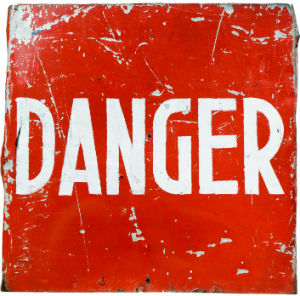
Danger! Don’t Optimize Presentations to Suck. Image via Shutterstock
Over the past 5 years I’ve given a few hundred presentations in front of crowds from 10 to 1,000.
I also make sure to attend other speakers’ presentations, sometimes to delight and sometimes to horror.
Despite that experience, I’m far from a perfect speaker. But I am passionate, knowledgeable and continuously trying to optimize my speaking skills. Part of this comes from feedback but also from watching people give presentations.
There are many mistakes I’ve made that all could have been avoided. I have a feeling this is the case for many. Whether you give presentations at conferences or internally, here are a few tips on what to avoid.
1. With panels, a moderator isn’t worth listening to, so don’t cooperate. Don’t reply to their requests to prep for the panel or answer any of their questions about your presentation.
2. Ignore who the audience is and why they’re in attendance. This is all about you baby.
3. If there are technical difficulties, freak out or better yet, just give up. You didn’t prepare, so there’s no reason to give the presentation sans PPT slides.
4. Do not be funny or complement the audience, conference and co-speakers. Remember, this is all about you.
5. Spend a lot of time talking about yourself and why you’re so awesome. Have at least 5 or 6 slides focused on you. Then a few more about your company.
6. If you’re on a panel, banter with other speakers that you’re old friends with and tell lots of inside jokes that the audience will be oblivious to.
7. Use as much stock photography as possible. Cats are good too. Kittens, actually. Meme it up.
8. Give the exact same presentation every time, just give the title a different name. Why go through the extra work?
9. Don’t include contact information on slides or a Twitter handle and hashtag to make it easy for people to share.
10. You’re the expert, so talk down to the audience. If they knew their stuff, they’d be on stage and not you, right?
11. Say umm, you know and ah. A lot.
12. Ignore what the session description says and talk about something related, but not really the same.
13. Speak in a monotone, quite voice and by all means, don’t show evidence of enthusiasm.
14. Use condescending commentary about your own examples, about competitors, the conference itself (including wifi).
15. Don’t bother citing sources when giving quotes or statistics.
16. Talk too fast. Overwhelm the audience with information and they’ll have no choice but to give up on doing it themselves and have to hire you.
17. Don’t follow a linear or logical structure. If movies can have simultaneous and erratic story lines, then your presentations should too.
18. Don’t give any practical examples or tell stories.
19. Spend all of your time “setting up the topic” and why it’s important. “How” can be covered some other time.
20. Blatantly pitch your own services or companies throughout. Make sure your slide templates use your branding in a way that covers at least 40% of the viewable slide area.
21. Don’t bother repeating the question being asked for others to hear when there’s no microphone for audience questions.
22. Deflect any questions you’re not interested in answering, “Great question but what I think you’re really asking is…”.
23. Interrupt other speakers and contradict the moderator. In fact, make jokes on Twitter about the other speakers and even the audience.
24. Forget about a takeaway slide that sums up the key points of the presentation.
25. No need to leave time for questions at the end. They should have been paying attention.
26. Whatever you do, don’t say thank you to the audience.
27. Make promises and then spam them. Tell the audience they can have a copy of your presentation if they leave a business card. Then spam the hell out of those emails.
28. Leave the room immediately. You’re a big deal and you have places to go, people to see.
29. On second thought, linger into the beginning of the next presentation and ignore requests to move things out into the hall.
That’s more than enough advice about what NOT to do with presentations. But surely you’ve experienced many others. Please share.
Giving relevant, interesting and sharable presentations have been an instrumental part of our digital marketing strategy. That’s right, presentations given in real life are part of our digital strategy. In today’s connected world, when you talk to one person, you’re talking to 1,000. So it follows that when you give a presentation to 100 people, you could be reaching thousands or more.
If you’re investing in the optimization of your content and advertising, then why not optimize the performance of your public speaking? Don’t ignore the impact of such a powerful means for connecting with people that want to buy from you or who can influence others to buy.


